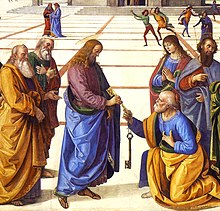 |
| This article is part of a series on |
| Vatican City |
|---|

According to Roman Catholicism, the history of the papacy, the office held by the pope as head of the Catholic Church, spans from the time of Peter to the present day.[1]
In the first three centuries of the Christian era, many of Peter's successors as bishops of Rome are obscure figures, most suffering martyrdom along with members of their flock in periods of persecution.[2] During the Early Church, the bishops of Rome enjoyed no temporal power until the time of Constantine. After the fall of the Western Roman Empire about 476, the medieval papacy was influenced by the temporal rulers of Italy; these periods are known as the Ostrogothic Papacy, Byzantine Papacy, and Frankish Papacy. Over time, the papacy consolidated its territorial claims to a portion of the peninsula known as the Papal States. Thereafter, the role of neighboring sovereigns was replaced by powerful Roman families during the saeculum obscurum, the Crescentii era, and the Tusculan Papacy.
From 1048 to 1257, the papacy experienced increasing conflict with the leaders and churches of the Holy Roman Empire and the Byzantine Empire (Eastern Roman Empire). Conflict with the latter culminated in the East–West Schism, dividing the Roman and Eastern Churches. From 1257 to 1377, the pope, though the bishop of Rome, resided in Viterbo, Orvieto, and Perugia, and lastly Avignon. The return of the popes to Rome after the Avignon Papacy was followed by the Western Schism: the division of the Western Church between two and, for a time, three competing papal claimants.
The Renaissance Papacy is known for its artistic and architectural patronage, frequent involvement in European power politics, and opposition against theological challenges to papal authority. After the start of the Protestant Reformation, the Reformation Papacy and Baroque Papacy led the Catholic Church through the Counter-Reformation. The popes during the Age of Revolution witnessed the largest expropriation of wealth in the church's history, during the French Revolution and those that followed throughout Europe. The Roman Question, arising from Italian unification, resulted in the loss of the Papal States and the creation of Vatican City.